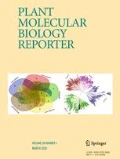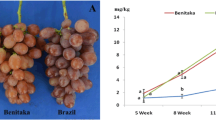Abstract
Anthocyanins play important role in plant protection and were closely involved with the plant evolution. Anthocyanidin synthase (ANS) is a late key enzyme in the flavonoid pathway which can catalyze leucoanthocyanidins to anthocyanidins. By our study, we found a miniature inverted-repeat transposable element (MITE) inserting in the promoter of ANS gene of mulberry. We used strawberry to evaluate the activities of ANS promoters from Morus alba and Morus notabilis with the method of Agrobacterium-mediated transient expression. The expression patterns of different promoters were also analyzed in transgenic lines of Arabidopsis thaliana and in this study, GUS was used as reporter gene. The 564-bp MITE insertion was strongly required for the activities of ANS promoter and it may reprogram the expression profiles of ANS gene in mulberry. Our results suggested that the MITE insertion was probably involved in either domestication or natural selection.



Similar content being viewed by others
References
Asano N, Tomioka E, Kizu H, Matsui K (1994) Sugars with nitrogen in the ring isolated from the leaves of Morus bombycis. Carbohydr Res 253(6):235–245
Barber, E.J.W. (1991) Prehistoric textiles: the development of cloth in the neolithic and bronze ages with special reference to the Aegean (Princeton University press)
Bovy A, Vos RD, Kemper M et al (2002) High-flavonol tomatoes resulting from the heterologous expression of the maize transcription factor genes lc and c1. Plant Cell 14(10):2509–2526
Chan KC, Hsiehhsun H, Huang CN et al (2009) Mulberry leaf extract inhibits vascular smooth muscle cell migration involving a block of small gtpase and akt/nf-κb signals. J Agric Food Chem 57(19):9147–9153
Chen C (2015) Overview of plant pigments [M]. Pigments in fruits and vegetables. Springer New York:1–7
Clegg MT, Durbin ML (2000) Flower color variation: a model for the experimental study of evolution. P Nat Acad Sci USA 97(13):7016–7023
Clegg MT, Durbin ML (2003) Tracing floral adaptations from ecology to molecules. Nat Rev Genet 4(3):206–215
Clough SJ, Bent AF (1998) Floral dip: a simplified method for agrobacterium-mediated transformation of Arabidopsis thaliana. Plant J 16(6):735–743
Czemmel, S., Heppel, S. C., Bogs, J (2012) R2R3 MYB transcription factors: key regulators of the flavonoid biosynthetic pathway in grapevine. Protoplasma, 249 Suppl 2(2), S109
Grayer RJ, Harborne JB (1994) A survey of antifungal compounds from higher plants, 1982–1993. Phytochemistry 37(1):19–42
He N, Zhang C, Qi X et al (2013) Draft genome sequence of the mulberry tree Morus notabilis. Nat Commun 4:2445
Holton TA, Cornish EC (1995) Genetics and biochemistry of anthocyanin biosynthesis. Plant Cell 7(7):1071–1083
Jefferson RA, Kavanagh TA, Bevan MW (1987) Gus fusions: beta-glucuronidase as a sensitive and versatile gene fusion marker in higher plants. EMBO J 6(13):3901–3907
Kim SY, Gao JJ, Lee WC, Ryu KS, Lee KR, Kim YC (1999) Antioxidative flavonoids from the leaves of Morus alba. Arch Pharm Res 22(1):81–85
Kim S, Bang H, Yoo KS, Pike LM (2006) Identification of the fourth allele of the ans (anthocyanidin synthase) gene and its effect on red color intensity in onions (Allium cepa). Euphytica 149(1–2):45–51
Koes RE, Quattrocchio F, Mol JNM (1994) The flavonoid biosynthetic pathway in plants: function and evolution. BioEssays 16(2):123–132
Li J, Lü RH, Zhao AC et al (2014) Isolation and expression analysis of anthocyanin biosynthetic genes in Morus alba L. Biol Plantarum 58(4):618–626
Li YS (2016) Advances in crop responses to enhanced uv-b radiation [J]. Appl Ecol Env Res 14(3):339–367
Lloyd AM, Walbot V, Davis RW (1992) Arabidopsis and Nicotiana anthocyanin production activated by maize regulators r and c1. Science 258(5089):1773–1775
Lukaszewicz M, Matysiak-Kata I, Skala J, Fecka I, Cisowski W, Szopa J (2004) Antioxidant capacity manipulation in transgenic potato tuber by changes in phenolic compounds content. J Agric Food Chem 52(6):1526–1533
Mao H, Wang H, Liu S, Li Z, Yang X, Yan J, Li J, Tran LSP, Qin F (2015) A transposable element in a NAC gene is associated with drought tolerance in maize seedlings. Nat Commun 6:8326
Madhuri G, Reddy AR (1999) Plant biotechnology of flavonoids. Plant Biotechnol 16:179–199
Mathews H, Clendennen SK, Caldwell CG, Liu XL, Connors K, Matheis N, Schuster DK, Menasco DJ, Wagoner W, Lightner J, Wagner DR (2003) Activation tagging in tomato identifies a transcriptional regulator of anthocyanin biosynthesis, modification, and transport. Plant Cell 15(8):1689–1703
Nepal MP, Ferguson CJ (2012) Phylogenetics of Morus (Moraceae) inferred from ITS and trnL-trnF sequence data. Syst Bot 37(2):442–450
Park KI, Al E (2007) A bHLH regulatory gene in the common morning glory, Ipomoea purpurea, controls anthocyanin biosynthesis in flowers, proanthocyanidin and phytomelanin pigmentation in seeds, and seed trichome formation. Plant J 49(4):641–654
Pawlowska AM, Oleszek W, Braca A (2008) Quali-quantitative analyses of flavonoids of Morus nigra L. and Morus alba L. (moraceae) fruits. J Agric Food Chem 56(9):3377–3380
Prescott AG, John P (1996) Dioxygenases: molecular structure and role in plant metabolism. Annu Rev Plant Biol 47:245–271
Qi X, Shuai Q, Chen H, Fan L, Zeng Q, He N (2014) Cloning and expression analyses of the anthocyanin biosynthetic genes in mulberry plants. Mol Genet Genomics 289(5):783–793
Reddy AM, Reddy VS, Scheffler BE, Wienand U, Reddy AR (2007) Novel transgenic rice overexpressing anthocyanidin synthase accumulates a mixture of flavonoids leading to an increased antioxidant potential. Meta Eng 9(1):95–111
Sanchez, M.D. (2000) World distribution and utilization of mulberry, potential for animal feeding. FAO electron. Conf. Mulberry animal prod. (Morus1-L) 1–11
Saito K, Kobayashi M, Gong Z, Tanaka Y, Yamazaki M (1999) Direct evidence for anthocyanidin synthase as a 2-oxoglutarate-dependent oxygenase: molecular cloning and functional expression of cDNA from a red forma of Perilla frutescens. Plant J 17(2):181–189
Salvi S, Sponza G, Morgante M, Tomes D, Niu X, Fengler KA, Meeley R, Ananiev EV, Svitashev S, Bruggemann E, Li B, Hainey CF, Radovic S, Zaina G, Rafalski JA, Tingey SV, Miao GH, Phillips RL, Tuberosa R (2007) Conserved noncoding genomic sequences associated with a flowering-time quantitative trait locus in maize. P Nat Acad Sci USA 104(27):11376–11381
Salvi S, Tuberosa R, Chiapparino E, Maccaferri M, Veillet S, van Beuningen L, Isaac P, Edwards K, Phillips RL (2002) Toward positional cloning of vgt1, a qtl controlling the transition from the vegetative to the reproductive phase in maize. Plant Mol Biol 48(5–6):601–613
Schofield CJ, Zhang ZH (1999) Structural and mechanistic studies on 2-oxoglutarate dependent oxygenases and related enzymes. Curr Opin Struct Biol 9:722–731
Wei L, Gu L, Song X, Cui X, Lu Z, Zhou M, Wang L, Hu F, Zhai J, Meyers BC, Cao X (2014) Dicer-like 3 produces transposable element-associated 24-nt sirnas that control agricultural traits in rice. P Natl Acad Sci USA 111(10):3877–3882
Wu X, Beecher GR, Holden JM, Haytowitz DB, Gebhardt SE, Prior RL (2006) Concentrations of anthocyanins in common foods in the United States and estimation of normal consumption. J Sci Food Agr 54:4069–4075
Yu M, Xiang Z, Feng L et al (1996) The discovery and study on a natural haploid Morus notabilis schneid. Acta Sericologica Sinica 22:67–71
Zou TB, Wang M, Gan RY, Ling WH (2011) Optimization of ultrasound-assisted extraction of anthocyanins from mulberry, using response surface methodology. Int J Mol Sci 12(5):3006–3017
Zuker M (2003) Mfold web server for nucleic acid folding and hybridization prediction. Nucleic Acids Res 31(13):3406–3415
Acknowledgments
This work was supported by grants from the Science and Technology Department of Guizhou Province (QKHSY[2015]3030), Fund of Guizhou for Construction of First-class Discipline in China (GNYL(2017)008), the Specialized Fund for the Top Talent of Science and Technology in colleges and universities in Guizhou (Grant No.[2016]075), and the Scientific and Technological Projects of Guizhou Province (Grant No.[2016]1401).
Author information
Authors and Affiliations
Contributions
Jun Li, Changying Liu, and Xiaoqing Liu designed the experiments and drafted the manuscript. Maode Yu and Aichun Zhao collected plant materials. Xiangyun Chen and Yaofeng Li performed identification of MITE. Changying Liu and Jun Li performed the constructing of plasmids and analysis of enzyme activities. Jun Li finished the transformation of Arabidopsis thaliana and histochemical assay. Changying Liu performed the real-time PCR experiments and analyzed the data. Xiangyun Chen and Yaofeng Li modified the manuscript.
Corresponding author
Ethics declarations
Conflicts of Interest
The authors declare that they have no conflict of interest.
Electronic supplementary material
ESM 1
(JPEG 73 kb)
Rights and permissions
About this article
Cite this article
Li, J., Liu, C., Zhao, A. et al. A MITE Insertion in the Promoter Region of Anthocyanidin Synthase from Morus alba L.. Plant Mol Biol Rep 36, 188–194 (2018). https://doi.org/10.1007/s11105-018-1069-z
Published:
Issue Date:
DOI: https://doi.org/10.1007/s11105-018-1069-z




